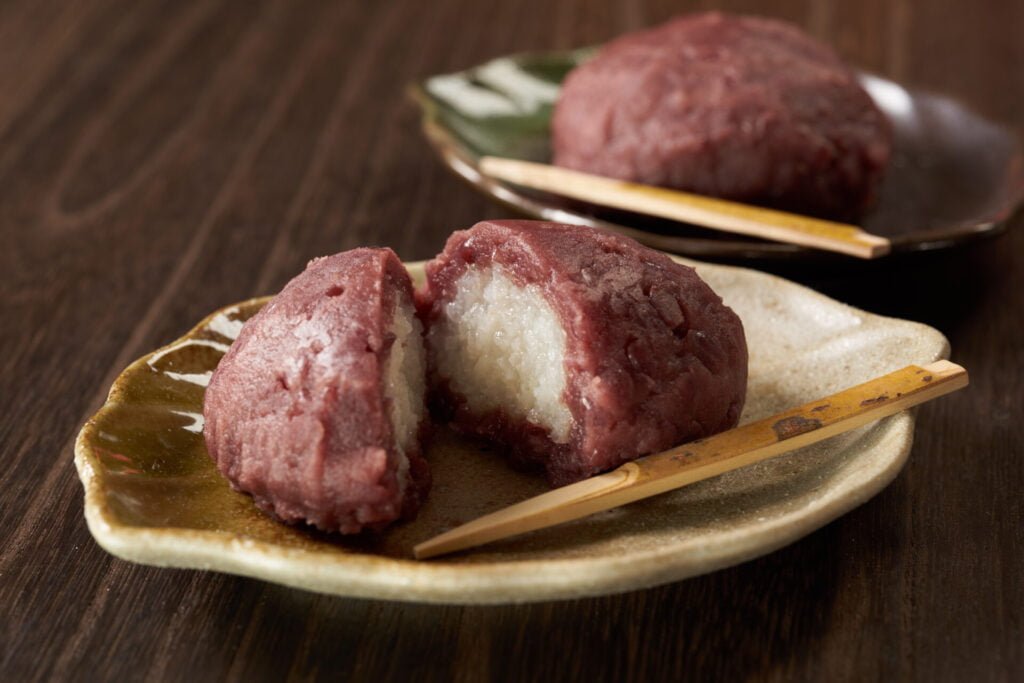The Secret of Ohagi: Unveiling the Healthy Charm of Traditional Wagashi
What is Ohagi: Unraveling the Allure of Traditional Japanese Sweets
Ohagi is a traditional Japanese sweet, or wagashi, made by mashing steamed glutinous rice and coating it with sweet red bean paste (anko), kinako (roasted soybean flour), or crushed sesame seeds. The name “ohagi” is derived from the autumn-blooming bush clover (hagi), and it’s traditionally eaten during the equinoctial week in autumn (the history of ohagi)
The charm of this Japanese sweet lies in the balance between the chewy texture of the glutinous rice and the sweetness of the coating. Despite its simple appearance, ohagi hides a wealth of nutritional benefits, making it a unique healthy dessert option among wagashi.

Nutritional Components of Ohagi: Unexpected Health Benefits
The main ingredients of ohagi – glutinous rice and red beans (you can find details about Japanese red beans here) – are packed with various nutrients.
Glutinous rice contains more protein and dietary fiber than regular rice. It’s also rich in B vitamins and minerals, particularly vitamin B1, which plays a crucial role in energy metabolism within the body.
Red beans are not only high in protein and dietary fiber but also contain a type of polyphenol called proanthocyanidin. This compound is known for its antioxidant properties and may help reduce oxidative stress in the body.
For ohagi coated with kinako (what is kinako), you can also benefit from soy isoflavones. These plant-based compounds are known as phytoestrogens and may contribute to women’s health.
The combination of these nutrients suggests that ohagi may offer health benefits beyond being a simple sweet treat. However, it’s important to note that more research is needed to fully understand these potential effects.
Ohagi and Diet: Considering Calories and Carbohydrates
While ohagi is nutritious, it’s also relatively high in calories and carbohydrates. A typical ohagi (about 100g) contains approximately 230 kcal and 50g of carbohydrates.
These figures might be a concern for those on a diet. However, considering the nutrients and dietary fiber in ohagi, it’s not necessarily a food to be completely avoided.
Rather, by consuming appropriate amounts at suitable frequencies, ohagi can be incorporated into a balanced diet while providing satisfaction. For instance, eating ohagi with vegetables or fruits can help balance the overall nutritional intake.
For those on a diet, it’s important to pay attention to the quantity and frequency of ohagi consumption, enjoying it as part of a balanced overall diet.
Dietary Fiber in Ohagi: Potential for Improving Gut Health
The dietary fiber in ohagi may contribute to improving gut health.
The fiber found in glutinous rice and red beans can serve as food for gut bacteria, potentially promoting the growth of beneficial bacteria. This may lead to improved gut environment and maintenance of digestive health.
Moreover, dietary fiber is known to help prevent and alleviate constipation. Combined with adequate water intake, the fiber in ohagi may promote smoother bowel movements.
However, it’s important to note that ohagi alone cannot provide sufficient dietary fiber, so it should be consumed in combination with other fiber-rich foods.
Ohagi and Exercise: Potential as an Energy Source
Due to its combination of carbohydrates and nutrients, ohagi is gaining attention as a potential energy source before and after exercise.
When consumed before exercise, the carbohydrates in ohagi can serve as an energy source, potentially improving performance. It may be particularly useful as a stable energy supply for long-duration endurance exercises.
Post-exercise consumption of ohagi may help replenish consumed energy and provide protein necessary for muscle repair. The combination of glutinous rice and red beans offers a good balance of carbohydrates and protein, potentially making it an effective recovery food.
However, the appropriate intake varies depending on individual exercise intensity and goals, so it’s recommended to seek advice from a professional.

Tips for Enjoying Ohagi Healthily: Incorporating it into a Balanced Diet
To enjoy ohagi as part of a healthy lifestyle, consider the following points:
- Mind the portion: Keep serving sizes moderate and consider the balance with other meals.
- Choose quality: When possible, opt for ohagi made with natural ingredients and minimal additives.
- Consider timing: Choose when to eat ohagi based on your body’s condition, such as when hungry or around exercise times.
- Combine with other foods: Eat ohagi alongside vegetables, fruits, or protein sources to balance nutrition.
- Enjoy homemade versions: Making ohagi at home allows you to control ingredients and sweetness levels.
Ohagi, while a traditional Japanese sweet, has the potential to be part of a healthy diet when consumed appropriately. By understanding its nutritional value and health effects, you can enjoy this traditional wagashi while maintaining a modern health-conscious lifestyle.
